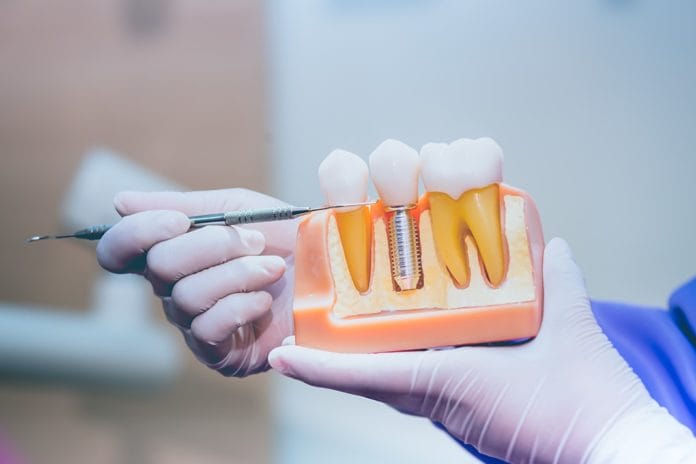Dental implant placement has gained popularity over the years as an effective, long-term tooth replacement option. Under the right conditions, dental implants have a success rate of 98%.1 However, dental implants have some drawbacks, such as implant failure due to smoking. Thus, a thorough patient screening is important prior to dental implant treatment planning.
A dental implant is a screw-like post that is placed into bone to offer a stable environment for a permanent tooth replacement. During the placement process, osseointegration occurs, which is the integration of bone into the screw-like ridges, creating a solid base for the permanent tooth replacement. Dental implants can replace one or more teeth or be used as a support for a permanent denture.2
Another benefit of a dental implant is that the placement of the implant maintains bone height, preventing future bone loss around the adjacent teeth. However, if the existing bone is not substantial in thickness, height, or consistency, a bone graft may be required prior to implant placement.
Impact of Smoking
Regardless of the high success rates of dental implants, smoking can be a major risk factor in the success of bone integration. The failure rate of a dental implant due to smoking reduces the success rate by 6.5% to 20%.3 However, the decreased success rate does not completely negate dental implants as a tooth replacement option for smokers.
Primarily, smoking and dental implant failure are more pronounced in the maxillary region. The higher failure rate of maxillary dental implants can be contributed to “poor quality of trabecular bone” as compared to the mandible.3 In addition, the effects smoking has on vasoconstriction by nicotine absorption into the bloodstream is a contributor to implant failure. The mandible may be less affected due to the area being protected and covered by the tongue. Therefore, there is a decrease in nicotine absorption.3
Smoking, also a precursor to periodontal disease, may affect dental implant healing by interfering with the “cellular protein synthesis” and impairing “the gingival fibroblast’s ability to adhere.”3 Although these interferences would intensify periodontal disease and decrease wound healing, the exact medium that compromises the wound healing process on a cellular level is unknown.
Nicotine, an active ingredient in tobacco use, is highly permeable and can penetrate gingival epithelium and interfere with the bone remodeling process.4 During the implant process, the gingival tissue presents with a longer junctional epithelium because of the lack of dental fibers. This creates tissue that is more susceptible to the penetration of nicotine and disrupts the bone osteoblastic process during bone integration, which, in turn, can result in a failed or weakened implant.
A study conducted by Emure Mumcu and Arzu Beklen compared marginal bone loss around implant-supported prostheses, finding that implant failure is higher in fixed implant protheses for smokers than a removable implant prosthesis. In addition, this controlled study indicated that smokers also have a higher plaque index than nonsmokers.4 The presence of plaque or biofilm formation can significantly alter implant stability. Cigarette smoke increases biofilm formation by altering the “key periopathogenic molecules.”4
Although smoking interferes with the osteoblastic process, implant failure has shown higher failure rates during and after abutment and prosthetic tooth placement than during the initial implant placement. Smoking can also affect bone grafting success if needed prior to implant placement.
Recommendations for Patients
When an implant is the desired tooth replacement option, a thorough medical/dental review must be initiated to determine optimal success. A review of the patient’s medical history includes current and past medical conditions, over-the-counter and prescription medications, and tobacco use. Also, a full comprehensive dental evaluation with the addition of dental x-rays, 3D imaging, models, and periodontal and gingival health should be performed.
If smoking is indicated during the medical history review, alterations to treatment recommendations prior to implementation may be indicated. Bain and Mayo recommend “patients should cease smoking at least one week prior to surgery” and “for at least two months after implant placement.”3 Following these recommendations will allow for a greater chance of blood circulation and platelet adhesion needed in wound healing while preventing interruption to the osteoblastic interruption during the osseointegration of the implant.3 The adjustments to a patient’s smoking schedule will help to ensure a positive environment for implant placement, although smoking cessation should be treatment planned for optimal implant success.
In addition, smoking has a negative effect on an increased plaque index due to biofilm formation, decreased marginal bone loss as a result of interference with osteoblastic activity, and the alteration of cellular activity. However, this does not negate the potential for implant placement for a smoker.
Although smoking is not the only indicated risk factor for implant failure, understanding the implications smoking has on long-term implant success is necessary for a successful treatment plan for an active smoker.
Before you leave, check out the Today’s RDH self-study CE courses. All courses are peer-reviewed and non-sponsored to focus solely on pure education. Click here now.
Listen to the Today’s RDH Dental Hygiene Podcast Below:
References
- Dental Implants. WebMD. Retrieved from https://webmd.com/oral-health/guide/dental-implants#2-4
- Dental Implant Surgery. Mayo Clinic. January 29, 2019. Retrieved from https://www.mayoclinic.org/tests-procedures/dental-implant-surgery/about/pac-203846222
- Kasat, V., Ladda, R. Smoking and Dental Implants. J Int Soc Prev Community Dent. 2012 Jul-Dec; 2(2): 38-41. Retrieved from https://www.ncbi.nlm.nih.gov/pmc/articles/PMC3894084/
- Mumcu, E., Beklen, A. The Effect of Smoking on the Marginal Bone Loss around Implant Supported Prostheses. Tob Induc Dis. 2019; 17: 43. Retrieved from https://www.ncbi.nlm.nih.gov/pmc/articles/PMC6662781/












